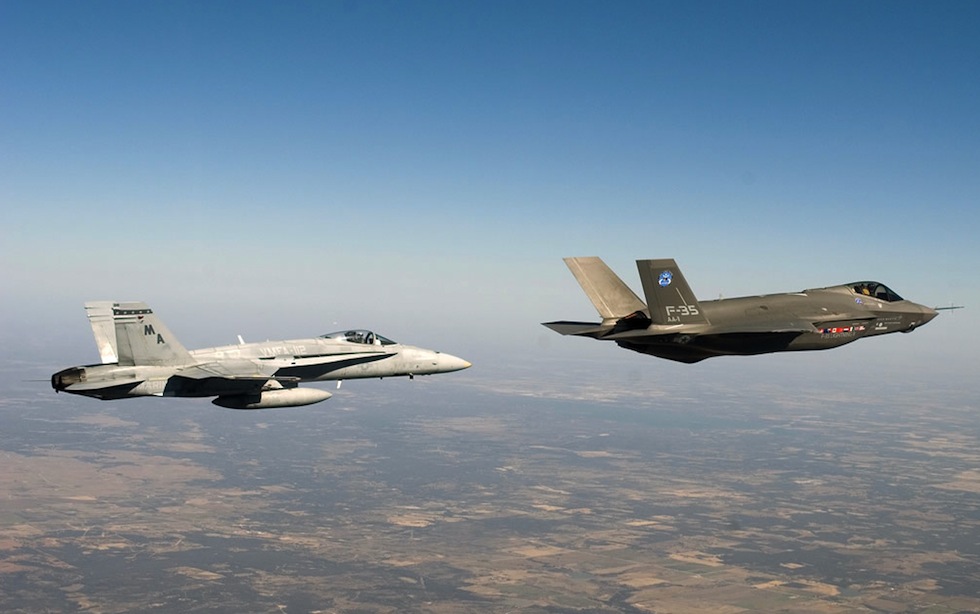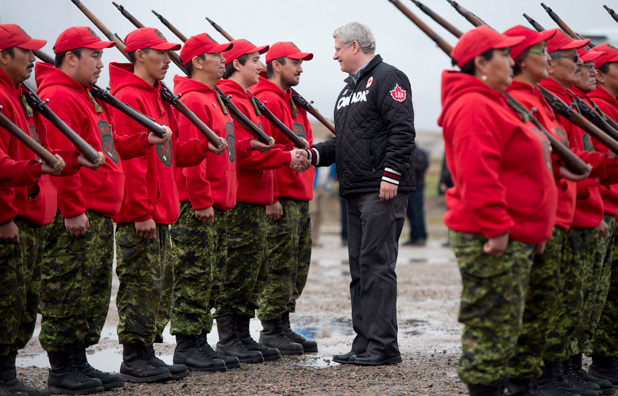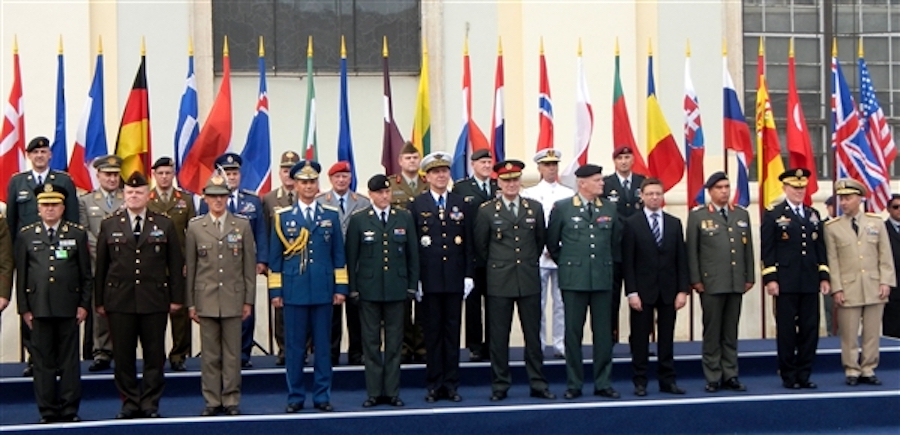By: Rodnie Allison
In four years Canada will receive the first of sixty-five F-35A multi-role combat aircraft. These aircraft represent much more than a means to regulate airspace or dictate conditions on the ground. They represent a commitment to the NATO alliance structure, the integration of strategic industrial resources among like-minded governments, and finally, the capacity to act with premier precision and stealth.
Economies of scale and prospects for interoperability make the F-35 very attractive from a procurement perspective. The variety of F-35 platforms available to NATO members and partnership countries render many current legacy fighters obsolete. Furthermore, Air Forces equipped with the F-35 will have access to large supply chains, up to date maintenance information and collective awareness on the battlefield. As of late 2010, there were 3,173 aircraft on order by partnering nations, and an expected 2000 in export sales.
Prospects for Canadian Industry
[captionpix align=”right” theme=”elegant” width=”380″ imgsrc=” http://f-35.ca/wp-content/uploads/2012/01/012512_2034_TheLockheed1.png” captiontext=” Major James Kettles speaks with Advanced Integration Technology (AIT) Canada staff in Aldergrove BC.”]
One of the central themes of the 2008 Canada First Defence Strategy is the role of Canadian industry within the domestic procurement process. “By unveiling a detailed plan for the future replacement of key equipment fleets, we are providing Canadian industry the opportunity to more effectively meet defence procurement requirements, and to position [Canadian industry] for global excellence.” Consequently, by signing on with the JSF program Canadian industry gains access to the F-35 supply chain. As of 2008, international content in the initial production of F-35 aircraft was approximately 20%. Lockheed Martin expects international content to potentially expand to about 30% as the program transitions to full-rate production.
Conventional industrial offset agreements were identified as economically inefficient early on in the JSF program. Given this, the program office selects participant nation contractors on the basis of “competitive best value” rather than national affiliation. As long as the contractors satisfy Lockheed Martin’s quality, price, and performance specifications, they would be entitled to bid on production contracts for the entire program. Therefore, Canadian aerospace companies can bid to supply parts not only to Canada’s 65-plane purchase, but the entire fleet of an estimated 3,000 to 5,000 aircraft.
In theory, this would increase the number of firms competing for any given subcontract thereby improving quality and reducing cost. The Industrial Participation Plan for Canada identified opportunities within the JSF program amounting to approximately $12 billion USD. To date, some 65 Canadian companies have received approximately $370 million in contracts related to the development and early production of F-35 parts and subsystems.
Cost
From the start, the JSF program was going to be the largest procurement contract in NATO history. Ten years in, the JSF program has been plagued by delays and cost overruns inflating original cost estimates from $233 billion to an estimated $385 billion. Such numbers have created an uncomfortable degree of uncertainty within partnering nations due to the correlation between unit cost and total aircraft produced. Simply put, the fewer produced, the more expensive each aircraft becomes.
[captionpix align=”left” theme=”elegant” width=”370″ imgsrc=”http://images.ctv.ca/archives/CTVNews/img2/20111118/800_mackay_panetta_halifax_cp_111118.jpg” captiontext=” Defence Minister Peter MacKay (left) and United States Secretary of Defense Leon Panetta address F-35 issue in Halifax.”]
In Canada, F-35 cost volatility concerns led to the commissioning of a Parliamentary Budget Office Report (PBO). To estimate the fly away cost of the F-35 the report plotted the cost of aircraft, according to historical trends, and cost/weight ratios. It found that the size of strike/fighter aircraft historically increases at about 0.5% per annum, and that the cost per kilogram grows significantly at about 3.5% per annum—doubling roughly every 18 years. Using this model the PBO calculated that the average unit acquisition cost would fall between $128.8 million to $148.5 million.
Amplifying costs concerns are the budget uncertainties affecting many Western counties. On January 26th 2012, US Defence Secretary Leon Panetta announced major reductions in the US defence budget and that JSF procurement “would be slowed.” With the US being such a significant partner in the program, buying more than 2/3 of the aircraft scheduled for production , there remain significant implications for the cost and delivery expectations of the partnering countries.
Over the short term the problems stemming from the delays will lead to significant adjustments. Countries with gaps between the retirement of legacy aircraft and the introduction of the F-35 will have some difficult decisions ahead. They will have to weigh the costs of waiting for the F-35 and making do with a reduced operational capability, or refurbishing their existing fleets and/or investing in another weapons system altogether. Australia, for example, is currently reviewing its delivery schedule and entertaining the possibility that it will reduce its original F-35 acquisition and divert resources to upgraded F-18 Super Hornets. In a European case, there have been unconfirmed reports indicating that the UK Ministry of Defence is evaluating the costs of leasing or acquiring carrier based French Rafales or F-18s to fill the impending shortage.
Given the size of American Strike Fighter fleets, the dilemma south of the border is much more acute. To fill the coming Strike Fighter Shortfall (SFS) the US Air Force plans to spend $2.8 billion to upgrade 350 of its F-16 multi-role fighter planes. The upgrades will keep the later model F-16 safely in service until the mid 2020s and offset the delayed acquisition of F-35s.
In 2010 the US the Department of the Navy (DoN) estimated that there would be a SFS of about 65 aircraft peaking in 2018–a gap reduced from over a hundred due to a diversion in resources from the JSF program to the refurbishment of F-18 Super Hornets. The shortfall has required US DoN to contribute increased resources to the High Flight Hour (HFH) inspection and the Service Life Extension Programs (SLEP). The HFH and SLEP efforts are designed to extend the F-18’s service life to 10,000 hours, thereby mitigating the impacts of the SFS.
Canada’s remaining 77 F-18s represent the exception rather than the rule in comparison to other JSF partner nations. According to Lieutenant-General André Deschamp Canada’s F-18 renewal, which began in 2002 and was completed in 2010, represented a significant investment in modernizing the F-18. In a statement to a parliamentary standing committee on national defence, Lieutenant-General Deschamp indicated that he was confident that Canada will be able to maintain current commitments all the way to 2020 with the current fleet of F-18s.
Foreign Buyers
Given the continued concern over increasing costs, declining orders and the weakened fiscal condition of many participating nations; pressure to expand external sales of the F-35 will continue to build. It will be interesting to see how this pressure is tempered by a collective anxiety to keep the F-35’s advanced technology confidential. Each country looking to acquire the F-35 will, no doubt, be vetted on a case by case basis.
December’s announcement that Japan would begin the process of procuring 42 F-35As provided a significant boost in confidence to the wider JSF program. The first of four F-35s to be ordered in fiscal year (FY) 2012 are slated for delivery in 2016. Navy Capt. John Kirby, a Pentagon spokesman, told reporters that Japan’s purchase of 42 of the stealth aircraft will be “a critical component of strengthening our partnership in the alliance, and [in] working to improve security in the region.”
The recent events in North Korea have reinvigorated Seoul’s security agenda as well. South Korea is looking to acquire 60 fifth-generation fighter jets with stealth capabilities. Currently Boeing, EADS and Lockheed Martin are the front runners in the competition. With an expected value of 8.29 trillion won (US$7.4 billion) a successful F-35 bid would further stabilize future F-35 procurement expectations.
With perspective buyers in Japan, South Korea, Israel, Singapore and Australia, the widespread adoption of the F-35 platform would do much to promote interoperability and cost effective maintenance and supply linkages within the East Asia region. More importantly, however, East Asian buyers would likely represent a larger share of future non-partner acquisitions. Talks of Indian and or Middle Eastern Air Force’s acquiring the F-35 are still in their infancy; however negotiations are steadily gaining steam.
If negotiations prove successful, and large scale acquisitions result, the implications for the wider JSF program would be significant. Pricing for individual units would drop and contracts for parts, maintenance, and training requirements would expand. Canadian industry, in particular, stands to benefit as the domestic aerospace sector is well positioned to compete for contracts within the JSF supply chain.
In Closing
It is clear that Lockheed Martin’s JSF program has introduced the most advanced multi-role strike fighter available today. The widespread adoption of stealth technology within many NATO fleets will significantly alter the way air campaigns start and are conducted. If it is a policy priority that Canada be involved in conflicts as they commence (as we saw in Libya), then stealth must also be prioritized within the Air force’s procurement strategy. With a radar cross-section 1,000 times smaller than that of the existing Canadian F-18s, any NATO plane lacking stealth will subsequently be relegated to decoy status.
[captionpix align=”right” theme=”elegant” width=”344″ imgsrc=”http://media.defenseindustrydaily.com/images/AIR_F-35A_and_F-18C_lg.jpg” captiontext=” F-35 and its predecessor, the F-18.”]
However, there is no denying that problems are rife within the JSF program. Price instability risks throwing the entire Joint Strike effort into a disastrous tailspin. With the majority of partnering nations slashing defence budgets there is renewed concern that the JSF program may not be out of the woods just yet. Slowed procurement rates, or entire cancellations will create gaps that will significantly increase the price of each unit, or increase reliance on “foreign” buyers–which in it of itself creates other risks.
As with all defence procurement, risk and its mitigation continue to provide impetus for advancement. In the case of the F-35 Joint Strike Fighter it is clear that NATO countries now have access to the most advanced multi-role aircraft ever produced. Canada’s involvement in the program provides access to significant industrial benefits, opportunities for interoperability, and it guarantees Canada a seat on the forefront of future NATO operations. But the question remains: at what price?
Further Reading: Industry Canada Joint Strike Fighter, Parliamentary Budget Office Report, F-35 Joint Strike Fighter (JSF) Program: Background and Issues for Congress, America‘s Self-Destroying Airpower,




